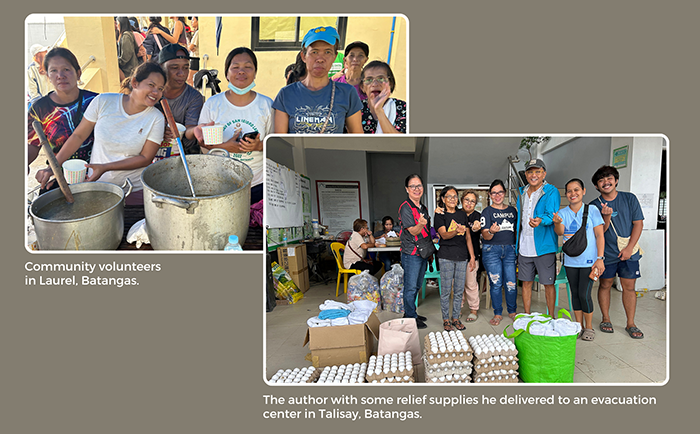All of us live with multiple identities, especially as we grow older. I started out, like all of us, as a child, then a student. I evolved to become a professional, then a husband and father. Now I am – gasp – a senior citizen and part-time gardener, but not yet a grandfather. All of you, sweet readers, are complex amalgams of various roles in life.
Then a disaster strikes, and many Filipinos quickly take on crucial roles as “volunteers.” It’s like armies of Clark Kents suddenly shedding civilian clothes to do extraordinary things.
I’ve seen it at various times in my lifetime as a journalist, ordinary people summoned by an innate goodness to help others. In the wake of the Baguio earthquake in 1990, I saw them digging out strangers from the rubble. After Supertyphoon Yolanda, I had friends desperately trying to reach Leyte to be of any kind of service.
So it was when Bagyong Kristine struck our backyard of Taal Lake in Batangas last week. Dozens died and hundreds lost their homes when landslides just below Tagaytay buried communities.
My wife, a lawyer and law professor in Batangas, sprang into action as a volunteer. She mobilized friends, neighbors, and former students to donate and deliver clothes, towels, and food. Her mom gave 30 trays of eggs, which came just in time for one group of evacuees who only had kalabasa to eat.
Other friends, Precious and Alex, quickly assembled their “Art Relief Mobile Kitchen” operation and set up a community kitchen in the worst hit lakeside town of Talisay, Batangas. Evacuees assisted them in preparing hot, nutritious meals for thousands of people.
Aside from my usual role as gatherer and spreader of factual information, I volunteered to be my wife’s driver. She and her former law student traveled to evacuation camps earlier this week to assess needs and deliver initial supplies of toiletries, beddings and towels.
Some stretches of road were lined with heaps of mud, uprooted trees and even abandoned cars, cleared just enough for vehicles to pass. A week after the tragedy, the evacuation centers were humming with volunteers, orderly lines of ayuda recipients, and playing children seemingly unaware that they had just lost their homes and all their possessions.
Newly displayed at one crowded center was the epal poster of a senatorial candidate, smiling happily at downtrodden disaster victims.
It was a stark reminder of the limits of volunteerism. A huge machinery of government using taxes from a large population exists not only to respond to emergencies but to prevent them.
Beyond the immediate humanitarian response, elected officials need to think about what this disaster tells us about our changing environment. A highly unusual volume of rain fell on fragile slopes above Taal Lake, exposing the vulnerability of people who live beside it.
In a world with climate gone haywire, extreme weather events will trigger more such disasters unless communities start moving away from vulnerable areas. According to conservationist and longtime climate change watcher Jose Ma Lorenzo Tan, “people need solutions away from coastlines, rivers and lakes.”
Tan co-authored a landmark study that looked at the vulnerability of low-lying urban centers and towns in coastal areas whipped by storms. These will become increasingly unlivable with the regularity of extreme weather, flooding, damage to infrastructure, saltwater intrusion, and loss of life.
He recommends migration to higher elevations away from major river systems, places like certain areas in Calabarzon and the fertile plateaus of Bukidnon.
Moving growing populations and keeping them safe will take extraordinary leadership, demonstrating will, courage, ingenuity, and initiative – the kind of traits that we typically see in many volunteers.
Veteran Kapuso journalist H. Severino writes occasional reflections for this website under a column entitled, “Essay.” In 2023, he was given the Gawad Balagtas, a lifetime literary achievement award given to Filipino writers by the Unyon ng mga Manunulat sa Pilipinas (UMPIL), the country's largest organization of Filipino writers.



